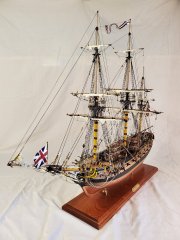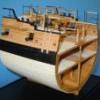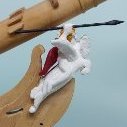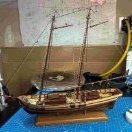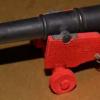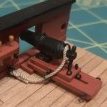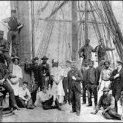Supplies of the Ship Modeler's Handbook are running out. Get your copy NOW before they are gone! Click on photo to order.
×
-
Posts
8,149 -
Joined
-
Last visited
Reputation Activity
-
 allanyed got a reaction from Techtonic in HMS Bellerophon by flyer - FINISHED - Amati/Victory Models - scale 1:72
allanyed got a reaction from Techtonic in HMS Bellerophon by flyer - FINISHED - Amati/Victory Models - scale 1:72
If you consider 3D printed barrels, the price is very low. Figure about $0.30-$0.50 each. All you need is an appropriate drawing in STL or other format that is 3D printer friendly. Check out the below for more details and a couple pics. These happen to be 17th century barrels (note the tapered trunnions for this era) but others are certainly doable as you can see in responding posts.
Allan
-
 allanyed reacted to Techtonic in HMS Bellerophon by flyer - FINISHED - Amati/Victory Models - scale 1:72
allanyed reacted to Techtonic in HMS Bellerophon by flyer - FINISHED - Amati/Victory Models - scale 1:72
I used Silkspan to do the furled sails on my Pegasus, I think it looks great for furled sails - you can see the results here https://modelshipworld.com/gallery/album/2554-hms-pegasus-164-amati-victory-models-by-techtonic/.
For set sails, while the silkspan may look more accurate to scale, I've a feeling the cloth sails may be more aesthetically pleasing. The cloth supplied with the Vanguard is very fine so might look reasonable. I'll probably experiment with both to see which looks best.
-
 allanyed got a reaction from mtaylor in Cleaning stained wood
allanyed got a reaction from mtaylor in Cleaning stained wood
This entire topic has been fascinating and extremely informative. I truly hope I never have to go back to this string for using the information. 😀
Allan
-
 allanyed reacted to dvm27 in dead eye twist
allanyed reacted to dvm27 in dead eye twist
Great and timely discussion for me as well! What I found confusing is that the illustration in Lees for cable laid is "inboard" but it isn't labeled "port, inboard". So this is how I'm rigging Speedwell with the above advice and Druxey's valuable assistance
Shrouds turned under deadeyes from right to left then, of course crossed over left to right above the deadeye. Thus, as mentioned above, the starboard shroud end is fore of the shroud and the port shroud end is aft of the shroud.
Don't forget the lanyard changes as well. On the port side the end knot is most fore deadeye hole and on the starboard it starts of the most aft deadeye hole (in other words opposite the shroud ends). I almost forgot that one.
Have I got it right? I have been looking at lots of contemporary models and have seen every variation of the above so maybe they weren't as obsessed with these minute details as we are!
-
 allanyed got a reaction from thibaultron in Cleaning stained wood
allanyed got a reaction from thibaultron in Cleaning stained wood
This entire topic has been fascinating and extremely informative. I truly hope I never have to go back to this string for using the information. 😀
Allan
-
 allanyed reacted to acaron41120 in 2nd Layer of Planking Glueing. Thinned or Standard wood Glue?
allanyed reacted to acaron41120 in 2nd Layer of Planking Glueing. Thinned or Standard wood Glue?
Quote from me. "I'll have to check on Titebond and see what the difference between Titebond and Titebond II is." Well I googled it and found out that not only titebond but in general wood glues DO NOT take stain. Then I searched for stainable wood glue and came up with this little tidbit. Elmer's Stainable Wood Glue Max contains real wood fibers that make it especially receptive to sanding and staining. I've been using Elmers wood glue max on all my builds. Go figure!
-
 allanyed got a reaction from dvm27 in dead eye twist
allanyed got a reaction from dvm27 in dead eye twist
Below is text and a picture from David Lees' Masting and Rigging of English Ships of War, page 42.
"A deadeye was turned in the end, left handed if shroud laid rope was used, right handed if cable laid."
I think this would have the ends finishing up aft on the port side and forward on the starboard side for cable laid rope as Henry mentions.
This view is from inboard.
-
 allanyed got a reaction from Techtonic in HMS Bellerophon by flyer - FINISHED - Amati/Victory Models - scale 1:72
allanyed got a reaction from Techtonic in HMS Bellerophon by flyer - FINISHED - Amati/Victory Models - scale 1:72
Your model is really looking good. I fully realize there are proponents of using cloth sails that are not so concerned with scale and the choice is always that of the model builder. Keep in mind that at 1:72 there is no cloth in existence or sewing method that will be to scale and many feel will detract from all the beauty you have put into your model to this point. Maybe consider non-woven materials. The $7 booklet on making sails by David Antsherl from SeaWatch books is a great guide on making realistic sails. Tom Lauria has a two part video on sail making that you may find helpful as well.
-
 allanyed got a reaction from mort stoll in HMS Bellerophon by flyer - FINISHED - Amati/Victory Models - scale 1:72
allanyed got a reaction from mort stoll in HMS Bellerophon by flyer - FINISHED - Amati/Victory Models - scale 1:72
Your model is really looking good. I fully realize there are proponents of using cloth sails that are not so concerned with scale and the choice is always that of the model builder. Keep in mind that at 1:72 there is no cloth in existence or sewing method that will be to scale and many feel will detract from all the beauty you have put into your model to this point. Maybe consider non-woven materials. The $7 booklet on making sails by David Antsherl from SeaWatch books is a great guide on making realistic sails. Tom Lauria has a two part video on sail making that you may find helpful as well.
-
 allanyed got a reaction from flyer in HMS Bellerophon by flyer - FINISHED - Amati/Victory Models - scale 1:72
allanyed got a reaction from flyer in HMS Bellerophon by flyer - FINISHED - Amati/Victory Models - scale 1:72
If you consider 3D printed barrels, the price is very low. Figure about $0.30-$0.50 each. All you need is an appropriate drawing in STL or other format that is 3D printer friendly. Check out the below for more details and a couple pics. These happen to be 17th century barrels (note the tapered trunnions for this era) but others are certainly doable as you can see in responding posts.
Allan
-
 allanyed got a reaction from flyer in HMS Bellerophon by flyer - FINISHED - Amati/Victory Models - scale 1:72
allanyed got a reaction from flyer in HMS Bellerophon by flyer - FINISHED - Amati/Victory Models - scale 1:72
Your model is really looking good. I fully realize there are proponents of using cloth sails that are not so concerned with scale and the choice is always that of the model builder. Keep in mind that at 1:72 there is no cloth in existence or sewing method that will be to scale and many feel will detract from all the beauty you have put into your model to this point. Maybe consider non-woven materials. The $7 booklet on making sails by David Antsherl from SeaWatch books is a great guide on making realistic sails. Tom Lauria has a two part video on sail making that you may find helpful as well.
-
 allanyed got a reaction from AON in HMS Bellerophon by flyer - FINISHED - Amati/Victory Models - scale 1:72
allanyed got a reaction from AON in HMS Bellerophon by flyer - FINISHED - Amati/Victory Models - scale 1:72
PEGASUS MODELS LTD 88 CATTON GROVE ROAD NORWICH NORFOLK UNITED KINGDOM Zip:NR33AA Phone: 44-1603-419515 Email: sales@pegasusmodels.co.uk WebSite: www.pegasusmodels.co.uk I don't know if this is current but they are a distributor for SIG, which makes silk span. https://sigmfg.com/products/sig-silkspan-tissue
Allan
-
 allanyed got a reaction from Scotty W in dead eye twist
allanyed got a reaction from Scotty W in dead eye twist
I may just be lucky but rarely have had this problem. Once the shroud is secured to the upper deadeye I hold the shroud between my thumb and forefinger at the top then run them down the shroud to get any twist out of it before running the lanyard through the deadeyes. Sometimes it takes a couple tries but it works.
Allan
-
 allanyed got a reaction from AON in HMS Bellerophon by flyer - FINISHED - Amati/Victory Models - scale 1:72
allanyed got a reaction from AON in HMS Bellerophon by flyer - FINISHED - Amati/Victory Models - scale 1:72
If you consider 3D printed barrels, the price is very low. Figure about $0.30-$0.50 each. All you need is an appropriate drawing in STL or other format that is 3D printer friendly. Check out the below for more details and a couple pics. These happen to be 17th century barrels (note the tapered trunnions for this era) but others are certainly doable as you can see in responding posts.
Allan
-
 allanyed reacted to Dr PR in Cleaning stained wood
allanyed reacted to Dr PR in Cleaning stained wood
Fungal spores are resistant to all ordinary treatments. They are inert - their metabolism is halted, waiting for the right conditions to "turn on" again. They can "wait" for decades. So the N2 treatment or other gasses or other mild treatments will have no effect. Only soaking with strong anti fungal agents (bleach is a good one) or high pressure steam will kill them, but neither of these treatments would be model friendly.
The wood will be filled with inert spores waiting for more moisture to germinate and continue to decompose the wood. So keeping the model dry is imperative. It should be stored in a sealed case with desiccant. The desiccant should be replaced periodically. A humidity indicator inside the case can be used to indicate when the desiccant should be changed. Some desiccants change color (white to blue) when they should be replaced.
If you are in good health I wouldn't worry much about the spores. The wood rotting fungi are not normal human pathogens. But they still can cause infections in people with an impaired immune system. More likely they will cause an allergic reaction.
-
 allanyed reacted to Dr PR in Cleaning stained wood
allanyed reacted to Dr PR in Cleaning stained wood
I have a PhD in microbiology, specializing in fungal physiology, and I operated a medical mycology (pathogenic fungi) lab for a number of years.
The grey stains look like dry rot - the same fungi that cause fences to turn gray with time. The fungi that cause this are dark grey to black (dematiaceae), and the stain runs deep into the wood. You can't wipe it off.
Mark is right - there probably is more mold on the inside, but if the wood has been dry for a while it won't spread more. But be careful! There will be spores and some of the fungi are opportunistic pathogens and can cause infections if your immune system is weakened for any reason (illness, chemotherapy, etc.). Don't breathe the dust or spores! Wear a mask!
You might be able to lighten the stain with kitchen bleach (sodium hypochlorite) or oxalic acid. Paint a bit on to the wood with a small brush and see what happens. Wash it off with water. Try it on a hidden place first if you can find one. This will not restore the original wood color, but may make the stain lighter and less noticeable. In any case the bleach will kill the fungus. You may need to remove any paint/varnish/shellac on the wood in order to get to the fungus.
Come to think of it, that's what we were doing with holystoning our decks. We used a bleach (oxalic acid) to lighten the wood! So you will be following tradition! Could be some real nostalgia there.
I wouldn't bet on this accomplishing much, but it might work.
-
 allanyed reacted to mtaylor in Cleaning stained wood
allanyed reacted to mtaylor in Cleaning stained wood
I agree with Druxey. If there's mould on the outside, there's probably a boat load (pun intened) on the inside and that's a real problem to get rid of.
-
 allanyed got a reaction from Mark P in HMS Montague 1779 by garyshipwright - 74-gun Alfred-class
allanyed got a reaction from Mark P in HMS Montague 1779 by garyshipwright - 74-gun Alfred-class
You are not alone Amalio!
Allan
-
 allanyed got a reaction from BenD in dead eye twist
allanyed got a reaction from BenD in dead eye twist
Below is text and a picture from David Lees' Masting and Rigging of English Ships of War, page 42.
"A deadeye was turned in the end, left handed if shroud laid rope was used, right handed if cable laid."
I think this would have the ends finishing up aft on the port side and forward on the starboard side for cable laid rope as Henry mentions.
This view is from inboard.
-
 allanyed got a reaction from Ian_Grant in HMB ENDEAVOUR by Peter6172 - FINISHED - Artesania Latina - 1/65
allanyed got a reaction from Ian_Grant in HMB ENDEAVOUR by Peter6172 - FINISHED - Artesania Latina - 1/65
Shipaholic
I agree based on a few sources mentioned above. Hopefully you have others you can share. The truss pendants replaced parrels on the lower yards and were around much longer than in the Endeavour era, lasting from 1760 to 1850. The rope pendants did change in that they rove downwards from 1760-1810 then upwards to blocks in the trestle trees from 1810 to 1850 and finally replaced with chain pendants from about 1850 on.
Allan
-
 allanyed got a reaction from robert952 in dead eye twist
allanyed got a reaction from robert952 in dead eye twist
Below is text and a picture from David Lees' Masting and Rigging of English Ships of War, page 42.
"A deadeye was turned in the end, left handed if shroud laid rope was used, right handed if cable laid."
I think this would have the ends finishing up aft on the port side and forward on the starboard side for cable laid rope as Henry mentions.
This view is from inboard.
-
 allanyed got a reaction from DaveBaxt in dead eye twist
allanyed got a reaction from DaveBaxt in dead eye twist
I may just be lucky but rarely have had this problem. Once the shroud is secured to the upper deadeye I hold the shroud between my thumb and forefinger at the top then run them down the shroud to get any twist out of it before running the lanyard through the deadeyes. Sometimes it takes a couple tries but it works.
Allan
-
 allanyed got a reaction from druxey in dead eye twist
allanyed got a reaction from druxey in dead eye twist
You are absolutely correct. This is the reason to check everything before putting it permanently in place, whether scratch built or kit supplied. There are thousands of contemporary plans and models to check against that are available for free on line at RMG, Wiki Commons etc. so why not use them? There is a myriad of books available based on contemporary information for those that wish to expand their library as well.
Allan
-
 allanyed got a reaction from thibaultron in dead eye twist
allanyed got a reaction from thibaultron in dead eye twist
You are absolutely correct. This is the reason to check everything before putting it permanently in place, whether scratch built or kit supplied. There are thousands of contemporary plans and models to check against that are available for free on line at RMG, Wiki Commons etc. so why not use them? There is a myriad of books available based on contemporary information for those that wish to expand their library as well.
Allan
-
 allanyed got a reaction from mtaylor in dead eye twist
allanyed got a reaction from mtaylor in dead eye twist
Below is text and a picture from David Lees' Masting and Rigging of English Ships of War, page 42.
"A deadeye was turned in the end, left handed if shroud laid rope was used, right handed if cable laid."
I think this would have the ends finishing up aft on the port side and forward on the starboard side for cable laid rope as Henry mentions.
This view is from inboard.



